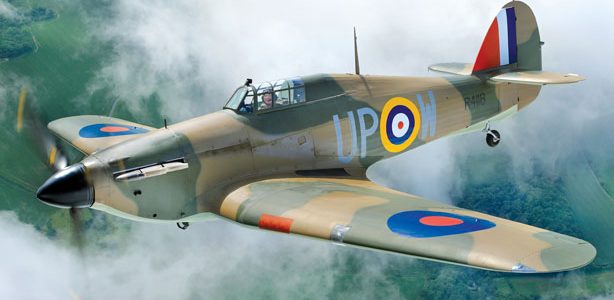If Hollywood had its way with history, the Supermarine Spitfire with its long slender fuselage and graceful elliptical wing, would most likely be portrayed as the lone defender over the White Cliffs of Dover during the Battle of Britain. Although the Spitfire played an important role in beating back the daily Luftwaffe raids, it was the tenacity of the pug-nosed Hawker Hurricanes of the RAF that bore the brunt of aerial combat during England’s darkest days. The Hurricane was slower than the Spit and it took longer to climb to altitude, but once it got there, the stubby little fighter jumped in and out of scrapes like a backstreet brawler.
Although the RAF Hurricane had its nose bloodied many times over by the German raiders, it was able to stay upright as it absorbed many punishing blows. British estimates credit the Hurricane with four-fifths of all German aircraft destroyed during the peak of the battle—July through October of 1940. Follow along with one of these Hurricane pilots as he slugs it out with the mighty Luftwaffe high over England.
Learning the ropes
I joined the RAF in 1939 because I thought it would be more glamorous to be shot down in a fighter than to be shot or bayoneted as a foot soldier in a trench! By November of 1939, I had already accumulated over 50 hours of flight time in a trainer called the Avro Cadet and progressed on to the Hawker Hart, Audax and Harvards. I only had five hours of retractable undercarriage time in the Harvard before I was “kicked out of the nest” in June of 1940 and sent on to a Hawker Hurricane operational training unit in Norfolk. My first flight in the Hurricane was almost my last as I tried to bust up a perfectly good flying machine.
There were no two-seat trainers and no pilot notes to study, just a seasoned Hurricane pilot standing on the wing, leaning into my cockpit telling me to push this button, pull this lever and turn this dial as I prepared for my maiden flight. I was able to start the Rolls-Royce Merlin engine under my hood with no problems as I waddled down the long grass runway trying to get my propeller into the correct pitch. I had it all backwards and it seemed like it took me forever to get airborne. With my propeller out of sync, I wondered out loud how I could ever fight a German fighter in this wretched machine! My attitude quickly changed however when I figured out my mistakes and managed to get the Hurricane into its proper flight régime. It was at that moment I began to appreciate the finer points of the Hawker Hurricane Mk I.
The Hurricane turned out to be a very easy airplane to fly and fight with. It had no real bad vices; it swung a little on takeoff and it would drop a wing if you got too slow—but both of these were easily corrected. Although you could get it to spin quite easily, you could get it out of the spin even quicker. I thought it was the perfect little airplane for the job we had to do.
Compared to the German Bf 109, the Hurricane was on an even playing field when it came to a turning circular dogfight, other than that the 109s had us beat on all fronts because they were faster and could fly higher. But their main weakness was the fact that they lacked the fuel capacity to stand and fight for any length of time. We in the RAF on the other hand, flew over our homeland so it was more or less a safe haven when our fuel gauges were low and it was time to land.
By RAF Wing Cmdr. Robert W. “Bob” Foster (Ret.)
As told to and written by James P. Busha

















Hawker did it right when they started producing the Hurricane, arguably the most beautiful of the WWII British fighters.
It was rugged, and in the hands of a seasoned pilot, was a machine to be reckoned with. The Hurricane was instrumental
in winning the Battle of Britain, with 656 German aircraft to it’s credit.It lacked the speed and agility of the Spitfire, but it
was easier to maintain and repair. Overall, for a plane that was basically the crossover from the wood framed bi-plane
to the low winged, metal framed monoplanes of WWII, it held it’s own special slot in aviation history.
I wonder if the early Hurricanes had wooden props (blades) just like the early Sptifires..